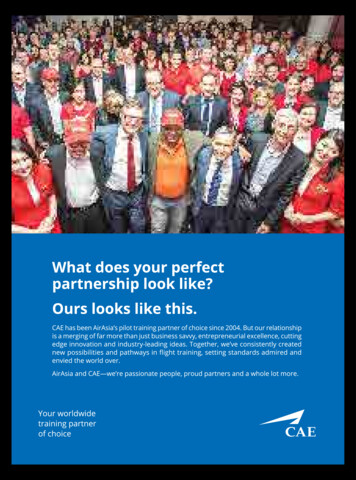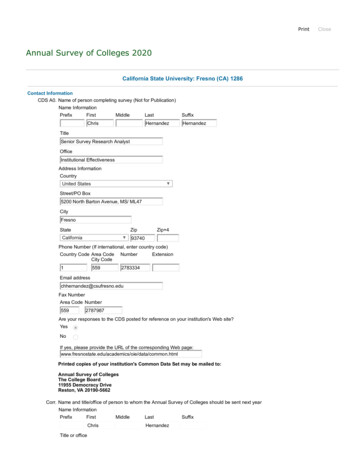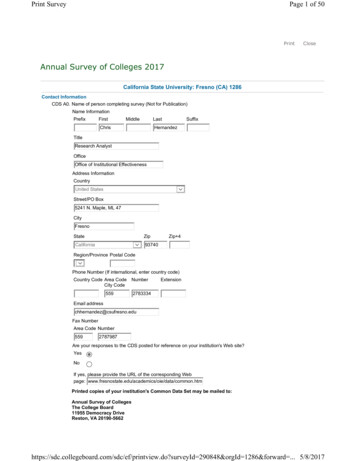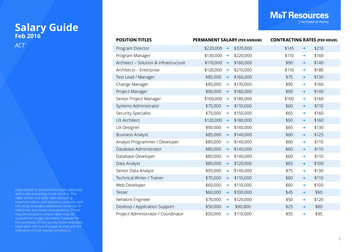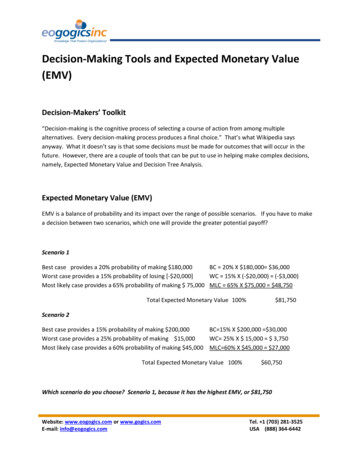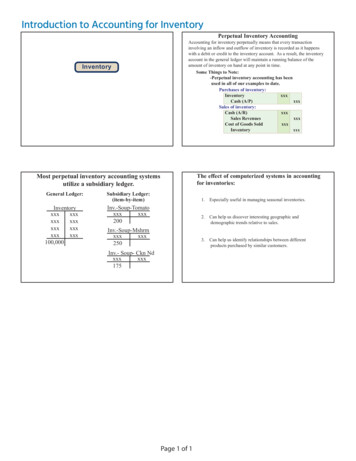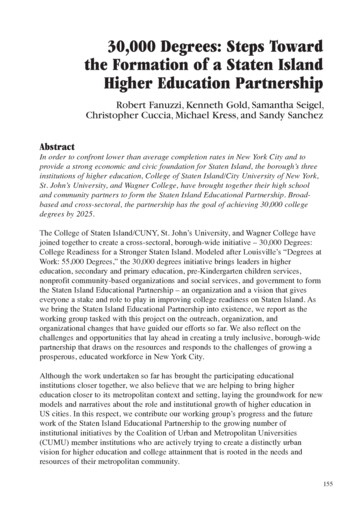
Transcription
30,000 Degrees: Steps Towardthe Formation of a Staten IslandHigher Education PartnershipRobert Fanuzzi, Kenneth Gold, Samantha Seigel,Christopher Cuccia, Michael Kress, and Sandy SanchezAbstractIn order to confront lower than average completion rates in New York City and toprovide a strong economic and civic foundation for Staten Island, the borough’s threeinstitutions of higher education, College of Staten Island/City University of New York,St. John’s University, and Wagner College, have brought together their high schooland community partners to form the Staten Island Educational Partnership. Broadbased and cross-sectoral, the partnership has the goal of achieving 30,000 collegedegrees by 2025.The College of Staten Island/CUNY, St. John’s University, and Wagner College havejoined together to create a cross-sectoral, borough-wide initiative – 30,000 Degrees:College Readiness for a Stronger Staten Island. Modeled after Louisville’s “Degrees atWork: 55,000 Degrees,” the 30,000 degrees initiative brings leaders in highereducation, secondary and primary education, pre-Kindergarten children services,nonprofit community-based organizations and social services, and government to formthe Staten Island Educational Partnership – an organization and a vision that giveseveryone a stake and role to play in improving college readiness on Staten Island. Aswe bring the Staten Island Educational Partnership into existence, we report as theworking group tasked with this project on the outreach, organization, andorganizational changes that have guided our efforts so far. We also reflect on thechallenges and opportunities that lay ahead in creating a truly inclusive, borough-widepartnership that draws on the resources and responds to the challenges of growing aprosperous, educated workforce in New York City.Although the work undertaken so far has brought the participating educationalinstitutions closer together, we also believe that we are helping to bring highereducation closer to its metropolitan context and setting, laying the groundwork for newmodels and narratives about the role and institutional growth of higher education inUS cities. In this respect, we contribute our working group’s progress and the futurework of the Staten Island Educational Partnership to the growing number ofinstitutional initiatives by the Coalition of Urban and Metropolitan Universities(CUMU) member institutions who are actively trying to create a distinctly urbanvision for higher education and college attainment that is rooted in the needs andresources of their metropolitan community.155
The Staten Island Educational Partnership has a still more vital connection to CUMU.Its signature initiative, 30,000 Degrees: College Readiness for a Stronger StatenIsland, is a direct outgrowth of Staten Island educational leaders’ participation in the2013 CUMU conference. The Staten Island Educational Partnership was formed inorder to achieve the results sought by a similar coalition of business, government,higher education, pre-K–12 education, and community organizations in Louisville. Thepartnership and the 30,000 is, therefore, a statement about what investment andparticipation in CUMU can accomplish. As more member institutions learn of similarinitiatives throughout the country, we are happy to offer 30,000 as an example of anorganizing, professionalizing potential that lies within CUMU and its journal.Origin of 30,000 DegreesIn 2013, representatives of the College of Staten Island, Wagner College, New DorpHigh School, Port Richmond High School, and Staten Island Technical High Schoolattended the Coalition of Urban and Metropolitan Universities conference in Louisvilleand learned about the work of “Degrees at Work: 55,000 Degrees.” Among the goals ofdegrees at work are the objectives “to improve the ease with which working adultsaccess the postsecondary system; to increase the affordability of education; to promotethe adoption of education-friendly programs, policies, and practices among Louisvilleemployers; to measure and report the completion rates of working-age adults who returnto school.” The Staten Island participants at the 2013 CUMU conference recognized theneed for such an initiative in their home borough and the benefits that could be realizedby expanding the traditional “feeder school” relationship between high schools andcolleges to include K–12 schools, business, and community organizations.After the conference, President William Fritz of the College of Staten Island andRichard Guarci of Wagner College presented this vision to Vice Provost JamesO’Keefe of the Staten Island campus of St. John’s University, and a three-collegepartnership was born. Although meetings of university presidents and executives arenot uncommon, this would be the first time that the three institutions of highereducation on the borough of Staten Island were devoting resources and strategic focusto a shared agenda: improving college readiness in the boroughThe executives of the three colleges formed a working group composed of Dr. MichaelKress, vice president of information technology and the Economic Development andCivic Prosperity unit for the College of Staten Island/CUNY; Sandy Sanchez, directorof the Economic Development and Civic Prosperity unit at the College of StatenIsland/CUNY; Dr. Kenneth Gold, dean of the School of Education for the College ofStaten Island/CUNY; Samantha Siegel, director of the Center for Leadership andCommunity Engagement for Wagner College; Dr. Christopher Cuccia, academicassistant vice president for St. John’s University; and Dr. Robert Fanuzzi, director ofcivic engagement and public programs for St. John’s University. Working closely withthe high school principals in their core high school partnerships, the 30,000 workinggroup moved quickly to establish a paradigm for their program goals and theirmethodology. The paradigm became summarized as a circular, mutually beneficial156
relationship that drew not only on the traditional “feeder school” relationships but alsoon the middle schools that delivered students to the high schools, and the communitycenters and organizations that supported the students outside their schools.About the Participating InstitutionsCollege of Staten Island/City University of New YorkThe College of Staten Island is a four-year, senior college of The City University ofNew York that offers exceptional opportunities to all of its students. Programs in theliberal arts, sciences, and professional studies lead to bachelor’s and associate’sdegrees. The master’s degree is awarded in eighteen professional and liberal arts andsciences fields of study. The college will now assume degree-granting authority of thedoctorate in physical therapy, and this will become effective for students enrolled inthe class of 2017 (beginning fall 2014). The college participates in doctoral programsof the city university graduate school and university center in biology, chemistry,computer science, nursing, physical therapy, and physics.The historic mission of The City University of New York (CUNY) has been to provideboth access to and excellence in higher education. The 2012–2016 master planarticulates “a steadfast insistence on the ability to serve students from all backgrounds,ensuring that each student has the opportunity to proceed smoothly through theeducational pipeline to degree completion . . . and a dedication to the university’surban setting.”157
As the borough’s only public institution of higher education and the second largestemployer on Staten Island, the College of Staten Island (CSI) plays an integral role indeveloping sustainable campus-community partnerships. Community engagement andservice/experiential learning components are integrated values and fundamentalprinciples of CSI’s strategic plan. We actively work to instill the value of educationand civic participation and are proud of our leadership role for Staten Island.Furthermore, CSI has committed internal university budget allocations dedicated tosupporting institutional engagement within the community. Under the auspices of asenior executive, the newly created Economic Development and Civic Prosperity unithas forged major inroads within the community, elected officials, educators, and civicand business leaders.St. John’s UniversityIn 1870, the Rev. John Loughlin, Bishop of Brooklyn, asked the Vincentiancommunity to establish an institution of higher education to serve a growingimmigrant population. The result was St. John’s College on Lewis Avenue inBrooklyn. The college grew into what is today known as St. John’s University, withfour campuses in New York—Queens, Staten Island, Manhattan, and Oakdale—andlocations around the world. As a Catholic and Vincentian university, St. John’s appliesits vast resources on behalf of those in need, combating the root causes of injustice andcreating paths to a more equitable world.St. John’s University’s commitment to Staten Island dates to the late 1960s, whenArchbishop Terrence Cardinal Cooke of the Archdiocese of New York asked theVincentian Fathers of St. John’s University to integrate Notre Dame College, apremiere but struggling small college that had been educating women since the 1930s,in order to maintain Catholic higher education in the borough. With the New YorkState Board of Regents approval in 1971, St. John’s has been a vibrant educationalforce on Staten Island for more than forty years, presently serving more than 2,000students who are enrolled in undergraduate and graduate degree programs. This uniquecampus, where the graceful buildings of the former Ganz estate stand alongside stateof the art technology centers, has graduated more than sixteen thousand students andcontinues to fulfill the promise of bringing together the academic rigor of a nationalCatholic university with the Vincentian mission, devoting its intellectual and physicalresources to search out the causes of poverty and social injustice and to encouragesolutions which are adaptable, effective, and concrete.Consistent with its mission and history, the Staten Island campus of St. John’s remainsfocused on the aspirations of the ever growing immigrant population in New York Cityand the needs of the underserved and marginalized, including access to educationalopportunities for nontraditional students. St. John’s University faculty and studentsexplore issues related to poverty and social injustice, enhancing their studies with skillbuilding experiences, community-based research, and academic service learning in theirlocal and global communities through the Vincentian Institute for Social Action, the158
Office of Campus Ministry, the Office of Global Studies, the College Advantageprogram, the Scholars Program, the School of Education’s Community EngagementProject, the Office of Adult & Veterans Services, and other programs and services.Wagner CollegeWagner College was founded in 1883 as the Lutheran Proseminary of Rochester, N.Y.,working to prepare future Lutheran ministers for admission to seminary. As the schoolgrew in reputation and size, the New York Ministerium, a Lutheran churchorganization in control of Wagner, recognized the need to find a new location.Reverend Frederic Sutter, a graduate and lifelong supporter of Wagner College, hadestablished his own ministry on Staten Island in 1907. Through Sutter’s efforts,Wagner College relocated to Grymes Hill on Staten Island in 1918. The new campusfound a home on the thirty-eight-acre former country estate of nineteenth centuryshipping magnate Sir Edward Cunard. Wagner’s move to Staten Island ushered in anew era in the history of Wagner in which the college became well known for itsliberal arts curriculum and, as a result, grew both in its academic reputation andenrollment over the next three decades.Today, Wagner College is uniquely positioned as the only true, private, traditionallyresidential liberal arts college within the five boroughs of New York City. More thantwo thousand students in more than thirty academic programs and four graduatedepartments make up the Wagner College community, which is ranked by U.S. News& World Report among the top twenty-five regional colleges and universities in thenortheast, continuing its tradition of academic excellence into the twenty-first century.Keeping with its tradition of community engagement, Wagner College is intimatelyconnected to the greater community locally, nationally, and internationally.The mission of Wagner College is to prepare students for life, as well as for careers, byemphasizing scholarship, achievement, leadership, and citizenship. Wagner offers acomprehensive educational program that is anchored in the liberal arts, experiential andco-curricular learning, and service to society, and that is cultivated by a faculty dedicatedto promoting individual expression, reflective practice, and integrative learning.Wagner College achieves this mission through the implementation and enhancement ofThe Wagner Plan for the Practical Liberal Arts, which was formally launched in 1998.This innovative and bold curricular framework is predicated on direct links betweentheory and practice. It builds upon Wagner’s history of combining liberal arts and focusedprofessional programs, coupled with our unique location and requires community-basedlearning for all students. The plan has, thus, ushered in a new vision of engaged studentlearning that is at once reflective and integrated, theoretical and practical.Working to deepen the Wagner plan, the Port Richmond Partnership was developed inthe spring of 2008 and is made up of representatives from Wagner College, leadingorganizations, and institutions in Port Richmond and focuses on the areas of education,economic development, immigration, health and well-being, and the arts. The159
partnership further demonstrates the Wagner commitment to learning by doing and torejuvenating a historically rich but economically distressed community. Thepartnership seeks to increase student learning, raise civic consciousness, and furthersustain its impact and commitment to the local community.Ralph McKee Career and Technical Education High SchoolRalph McKee Career and Technical Education High School has been a leadingrepresentative of Staten Island in career and technical education (CTE) for more thanninety years. McKee is like a private school, with small classes, committed faculty,secure grounds, and sophisticated technologies. Led by Principal Sharon Henry,McKee provides students with the knowledge, study habits, resources, and guidancenot only to go to college, but also to thrive once accepted by equipping students withthe skills and certifications to pursue career fields like drafting, graphic arts,CISCO/A networking, automotive technology, cosmetology, and construction. Today,as it prepares youth for key roles in the twenty-first century, McKee’s motto is,“McKee: College, Career, Life.” As a recipient of a Bill and Melinda GatesFoundation grant to start the Advancement Via Individual Determination (AVID)program, McKee stands as the only AVID certified CTE secondary school in theNortheast region. In 2013, it was one of thirteen schools to be awarded a BloombergTechnology Initiative Software Engineering Program (SEP), through which studentsare on a path to receive New York state certification as a CTE designation on theirhigh school diploma. Other recent achievements include a first place in desktoppublishing and design and third place in package design in the 2014 Citywide GraphicArts Competition; both a first and third place finish in the 2014 Greater New YorkAutomotive Dealer’s Association automotive technician citywide competition; secondplace finishes for both advertising design and architectural drafting in the 2014 SkillsUSA New York City Area 5 competition; and both first and second place finishes indesktop publishing and design in the 2013 Citywide Graphic Arts Competition.New Dorp High SchoolNew Dorp High School serves more than twenty-seven hundred students in gradesnine through twelve. Its student population is 51 percent White, 27 percent Hispanic,12 percent Black, and 7 percent Asian. Seventeen percent are special educationstudents, and 4 percent of students are English language learners (ELLs). More than 57percent qualify for free or reduced-price lunch. The school is located on the east shoreof Staten Island. Principal Deirdre DeAngelis has led the school since 1999.New Dorp High School has implemented a variety of structural and instructionalsystems using data to develop school-wide approaches to improve student outcomes.Through an inquiry approach, staff and administrators continually identify areas forgrowth and strategize possible levers for improving student outcomes. Concernedabout the school’s graduation rate, they divided the large, comprehensive high schoolinto eight Small Learning Communities (SLCs in 2006), each with a specific careerfocus, a dedicated administrator, guidance counselor, teaching staff, and other supportstaff to create a personalized environment to better meet the needs of all students.160
Academically, they focused on writing as a growth area throughout the school basedon analysis of student data. As a result, all teachers have been supported in explicitlyteaching analytic writing in their content areas. With more than a 22 percent pointincrease in their four-year graduation rate since 2006, the results are starting to show.Parents and families are key partners in New Dorp’s turnaround—a widely used onlinegrading and information sharing system keeps them updated and allows them tocommunicate with teachers regularly.Port Richmond High SchoolThe mission of Port Richmond High School is to provide students with individualizedchallenges, opportunities, and resources, to become lifelong learners and productive,responsible citizens. Port Richmond High School believes that all students can learnand achieve at a high level of expectation given the proper attention to their individualneeds. Principal Timothy Gannon believes that close community partnerships withcolleges, universities, and local organizations help enhance students’ educationalexperience and provide them with multiple options. In 2013, 61.1 percent of PortRichmond High School students graduated in four years and about 50 percent ofstudents graduated with a weighted diploma. Overall, the school received a B forcollege and career readiness with around 75 percent of graduates taking academicallyrigorous classes and 43 percent enrolling in postsecondary classes after graduation.Staten Island Technical High SchoolStaten Island Technical High School is among the prestigious New York City’sspecialized high schools. The admissions process is highly competitive and based uponthe specialized high school admissions test, which is taken annually by more thantwenty-seven thousand New York City students. All ninth grade students receive aniPad to use in school and take home for four years via the 1:1 Digital EducationInitiative. The school’s college preparatory curriculum provides a robust andchallenging experience through courses in science, technology, engineering, arts, andmathematics (STEAM), as well as the liberal arts and health and physical education,along with a cutting edge career and technical education program and extensive PublicSchools Athletic League (PSAL) opportunities for the scholar-athlete. Staten IslandTechnical High School is one of our nation’s top high schools, with all core coursestaught on the honors level and featuring one of the best college preparatoryexperiences across the curriculum, with a strong emphasis in STEAM education, andpremier college and career readiness programs, producing the nation’s finest scholars,innovators and athletes.Staten Island Technical High School was recently ranked sixth in Newsweek’s 2014 listof America’s top high schools. One hundred percent of Staten Island Tech’s graduatesgo on to four-year colleges and universities, including the service academies. The 293students of the class of 2014 earned 61 million in college scholarships, with moststudents earning sixteen to sixty college credits via the school’s vast AdvancedPlacement program and dual-enrollment college accredited courses. Pivotalpartnerships with the College Board’s Advanced Placement program, CUNY College161
Now, SUNY University in the High School, St. John’s University College Advantage,and the College of St. Rose provide students with the opportunity to earn and graduatewith fifteen to sixty college credits. Over 60 percent of the faculty members teach APand college-level courses.About Staten IslandAs the smallest of New York City’s five boroughs, Staten Island has come into sharperlocal focus and into national consciousness in the wake of super storm Sandy. Itcurrently ranks fourth among the five boroughs in the rate of college degrees byborough residents:Percentage of Borough Residents with a Baccalaureate Degree or Higher2010 census data informs us that the percentage of persons aged twenty-five or over(2007–2011) who have attained a baccalaureate degree or higher is 28.9 per cent(136,040 degrees) of the island’s 470,728 residents. Based on the analysis of StatenIsland population growth and recent trends in higher education, a goal of thirtythousand additional degrees from the baseline 2012 census will require an increase of2,128 degrees above the trend over the ten-year period from 2015–2025. Also, basedon the national average completion rate of 50 percent this would require an additional426 college-ready high school graduates per year who choose to go to college (UnitedStates Census Bureau Report 2014).162
An extra opportunity and incentive for the Staten Island Educational Partnership toreach these goals is the 35 percent increase in the foreign-born population in theborough from the census years 2000 to 2010. According to the U.S. Census Bureau2008–2012 American Community Survey, the foreign-born will number 97,369 out ofa total population of 468,374, almost a quarter of the population. Will Staten Island’snewest residents become part of the borough’s educational progress? The Staten IslandEducational Partnership was formed with this challenge in mind.The Staten Island Educational Partnership made a close study of other relevantdemographic trends that will inform its focus and outreach.Using information collected from the 2012 American Community Survey and the 2010US Census, a report issued by St. John’s University found that other than the Bronxand Staten Island, all the other boroughs will see increases in the ten to fourteen agegroup in 2015. The entire city will grow in population by about 5.2 percent. StatenIsland will have the largest decrease in the ten to fourteen age group at –4.4 percent.Overall, the fifteen to seventeen age population will decrease by about 6.5 percentaround the city.White population will continue to decrease in the Bronx, Queens, and Staten Islandand increase slightly in Brooklyn and Manhattan. Staten Island has the largest increase163
in Black population by 75 percent since 1990. Black population will decrease about2.6 percent in 2015 for all but Staten Island, where it will increase by 5.4 percent.Asian populations will increase across all of the boroughs by 9 percent in 2015, withStaten Island having the largest Asian population increase at 167 percent since 1990.Hispanic populations have increased in population across the boroughs by about 35percent since 1990, with Staten Island having a 204 percent increase in Hispanicssince 1990. In 2015, projections show Staten Island’s Hispanic population increasedby 16.5 percent.The population has increased across Staten Island by about 16 percent since 2000. Thelargest increases were in Charleston (31 percent), Tottenville (30.8 percent), and PortIvory with about 26 percent. Overall, population in Staten Island will grow by about 4percent from 2010 to 2015, but the borough will see decreases in the ten-to-fourteenage population in the –4 percent range by 2015. Since 2000, the ten-to-fourteen agepopulation has decreased at a rate of about –3.5 percent over fifteen years. High schoolaged populations will reach their peaks in 2012–2013 and then will be followed by along and gradual decrease in population throughout this decade. The fifteen-toseventeen aged population reached its highest point in 2010–2011, but decreases willbe about –7 percent by 2015.According to the same St. John’s University report, the borough will see increases inthe percentage of residents without a bachelor’s degree.The knowledge that the borough is lagging in college attainment and projected tocontinue to lag spurred the 30,000 working group to ramp up their outreach efforts tohigh schools to see if existing programs could be intensified or more strategicallyutilized (Ross, Cuccia, and Hughes 2012).164
College/High School Partnerships UnderwaySt. John’s University has begun an in-depth partnership with McKee High School inthe St. George neighborhood of Staten Island that implements the Advancement ViaIndividual Determination program. Housed in McKee High School, the AVIDsecondary program (grades seven through twelve) “develops learning, study, andacademic behavioral skills that are essential to success in rigorous coursework. It actsas a catalyst for schools to develop a culture of college readiness for all students acrossthe campus. In the AVID elective class, students receive daily instruction and supportto prepare them for college from a trained AVID elective teacher. AVID impactsstudents school-wide as academic strategies like writing to learn, inquiry,collaboration, organizational skills, and critical reading (WICOR ) are taught in allclasses by teachers who have been trained to use AVID strategies in their specificcontent areas.” An essential part of AVID’s program delivery are the college tutors,who “create a positive peer group for students” and help them “a sense of hope forpersonal achievement gained through hard work and determination.” Working closelywith high school students, college students provide the crucial mentoring andacademic follow up that is necessary for the success of AVID.St. John’s School of Education faculty member professor Kristin Pitanza is the liaisonand coordinator for delivery of the AVID program at McKee, supervising students fromthe School of Education and from the St. John’s University core class, Discover NewYork. She reports that the close relationship between AVID trained teachers and the St.John’s University student tutors is already paying dividends. The AVID tutor sessionsuse college tutor facilitators to pose problems, lead inquiry-based learning activities, andto collectively develop solutions to the problems posed by students. The AVID approachrewards the student who has the best question and helps others learn to develop similarproblem-posing skills. Students are empowered to become leaders and are maderesponsible for envisioning and performing higher level work outside the classroom.Working together, content area teachers and college tutors are devising tutoring outcomesthat will help the content area classroom and teacher reach their desired goals. Bypreparing students for more demanding tutoring questions, St. John’s University studentsand the content area teachers of McKee High school are preparing their high schoolstudents for success in college by modelling and demanding a higher level of performanceand participation. St. John’s University students also learn about the motivational andprogrammatic challenges that lay ahead in the field of college readiness.Principal Sharon Henry reports with great satisfaction on the working relationship andlevel of cooperation achieved so far between St. John’s University and McKee HighSchool and looks forward to achieving tangible outcomes in college readiness as theprogram continues throughout the academic year.St. John’s University also administers the College Advantage Program in the followinglocal high schools: Curtis High School, Miraj Islamic School, Moore Catholic HighSchool, Monsignor Farrell High School, New Dorp High School, Notre Dame165
Academy, Staten Island Technical High School, St. John Villa High School, St.Joseph-by-the-Sea Academy, St. Joseph Hill Academy, St. Peter’s Boys High School,Susan Wagner High School, and Tottenville High School.Wagner College believes that comprehensive neighborhood partnerships are the mosteffective ways for institutions of higher education to align with like anchor institutionsin order to achieve long-term measurable and sustainable community good. Consideredthe cornerstone of the curricular framework, the Wagner Plan for the Practical LiberalArts/Port Richmond Partnership seeks to develop collaborative programs that contributeto school improvement, economic growth, health care enhancement, and immigrationreform. The partnerships play a significant role in advancing research and inquiry aboutpressing community issues and builds mutually beneficial curricular and co-curricularplacements for Wagner College students to broaden their experiences and strengthen awide variety of community-based initiatives.Community leaders first broached the Port Richmond Partnership in 2008 as a wayto augment Wagner’s highly successful Civic Innovations Program. A Memorandumof Understanding was signed in the spring of 2009, officially establishing thepartnership. Based on an agreement between Wagner College and leadingorganizations and institutions in Port Richmond, the partnership was designed toextend Wagner’s commitment to learning by doing and to rejuvenating aneconomically distressed community.Over the past three years, the number of partnership organizations has doubled, andthrough regularly scheduled meetings, partners have worked together closely to tapinto existing community assets by continuing to build significant, sus
Wagner College Wagner College was founded in 1883 as the Lutheran Proseminary of Rochester, N.Y., working to prepare future Lutheran ministers for admission to seminary. As the school grew in reputation and size, the New York Ministerium, a Lutheran church organization in control of Wagner, recognized the need to find a new location.


